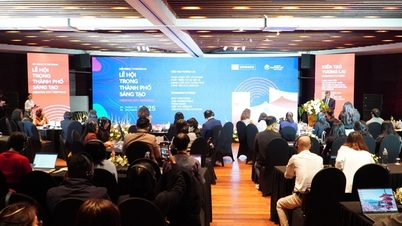To keep up with the 4.0 era, businesses are gradually applying powerful digital technology to production and business processes, especially product commercialization to improve efficiency, enhance competitiveness and improve customer experience.
According to the Digital Economy Report 2024 compiled by the United Nations Conference on Trade and Development (UNCTAD) with data from more than 200 countries, about 60% of small and medium-sized enterprises have applied digital solutions to their business processes (an increase of 15% compared to 2022).
This is the lever to increase the total value of global e-commerce transactions in 2024 to an estimated 6,300 billion USD (up 17% compared to 2023). In particular, advertising trends are considered a compass to forecast consumer behavior, helping businesses create marketing strategies with the best performance.
 |
| 2025 will be the year of livestream explosion as the trend of direct-to-consumer (D2C) sales increasingly asserts its dominance. |
According to Dr. Truong Gia Bao, Vice President of the Vietnam Advertising Association (VAA), President of the Vietnam Advertising and Digital Content Association (VDAA), digital advertising and online advertising will "reign" in the coming time.
Product advertising trends will focus on social networking platforms, livestreaming and personalized advertising trends. In particular, livestreaming sales is becoming the leading marketing trend in terms of implementation and effectiveness in the e-commerce industry.
2025 will be the year of livestream explosion as the trend of direct-to-consumer (D2C) sales increasingly asserts its dominance. Livestream can contribute 20% of e-commerce sales by 2026, with 3 popular platforms being Facebook, Shopee and TikTok. Currently, there are up to 2.5 million livestream sessions/month, attracting more than 50,000 sellers.
Advertising products on e-commerce platforms and applying artificial intelligence (AI) are also trends that experts predict will explode in the near future.
The Department of E-commerce and Digital Economy ( Ministry of Industry and Trade ) said that AI has the ability to suggest products that suit customers' needs and preferences by analyzing big data from their previous shopping behavior, including purchase history, viewed products, feedback or product reviews... From there, businesses can adjust products, services or marketing strategies to better suit customers' needs.
In addition, from market data and customer data, AI can forecast future product trends and demand. This helps businesses adjust product and marketing strategies to meet market demand and maintain competitive advantage.
 |
| Enterprises display and introduce products at the India and Central Highlands Business and Investment Conference. |
According to VAA, by 2024, 40% of businesses will be recruiting AI experts to support their marketing teams. This confirms the role of AI in disrupting advertising strategies. Notably, 65% of business leaders believe that AI will create an impact equivalent to the industrial revolution, opening up huge growth opportunities for brands. AI is widely used in advertising activities such as: content creation, learning and skill development, data analysis and reporting, market research support, content ideation, marketing automation.
Mr. Hoang Minh Ngoc Hai, Director of the Center for Innovation and Business Connection - Provincial Business Association, General Director of Ea'Go Digital Joint Stock Company shared that currently, businesses are in the period of "5-No Trade" (no borders, no waiting, no patterns, no fixity, no sleep). However, AI will defy the limits and open up many opportunities for businesses with "5-No Trade". AI is not just a tool, but an extremely intelligent "digital assistant". As long as businesses know how to take advantage of it, AI can automatically coordinate many different platforms, from accounting to customer care, from internal operations to marketing.
In addition, according to the Vietnam E-commerce Index 2025 (EBI 2025) Report of the Vietnam E-commerce Association (VECOM), cross-border e-commerce (CBEC) on a global scale has grown strongly in recent years, especially CBEC following the business-to-consumer model. The rapid development of information and communication technology as well as logistics services has strongly supported cross-border online retail activities (B2C). In particular, the strong "landing" of online exports is an important pillar of fast and sustainable e-commerce development.
| According to the Institute of Brand Strategy and Competition, Vietnam currently ranks 16th in the top 20 countries with nearly 50 million Internet users, of which 60% are young people; the average growth rate is 15%/year. The Internet has become the most popular source of advertising information for users to know about products. 73% of Vietnamese consumers search for information on the Internet before making a purchase. |
Source: https://baodaklak.vn/kinh-te/202506/bat-nhip-voi-quang-cao-thoi-40-b871258/




![[Photo] National Assembly Chairman Tran Thanh Man attends the VinFuture 2025 Award Ceremony](/_next/image?url=https%3A%2F%2Fvphoto.vietnam.vn%2Fthumb%2F1200x675%2Fvietnam%2Fresource%2FIMAGE%2F2025%2F12%2F05%2F1764951162416_2628509768338816493-6995-jpg.webp&w=3840&q=75)


![[Photo] 60th Anniversary of the Founding of the Vietnam Association of Photographic Artists](/_next/image?url=https%3A%2F%2Fvphoto.vietnam.vn%2Fthumb%2F1200x675%2Fvietnam%2Fresource%2FIMAGE%2F2025%2F12%2F05%2F1764935864512_a1-bnd-0841-9740-jpg.webp&w=3840&q=75)






























































































Comment (0)